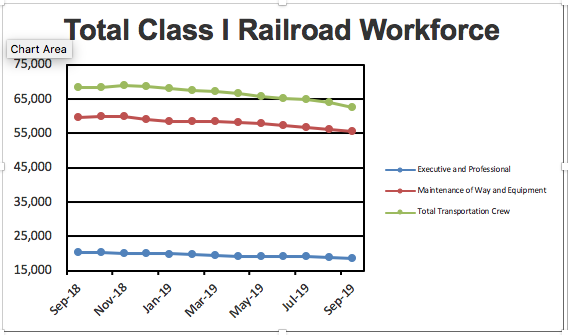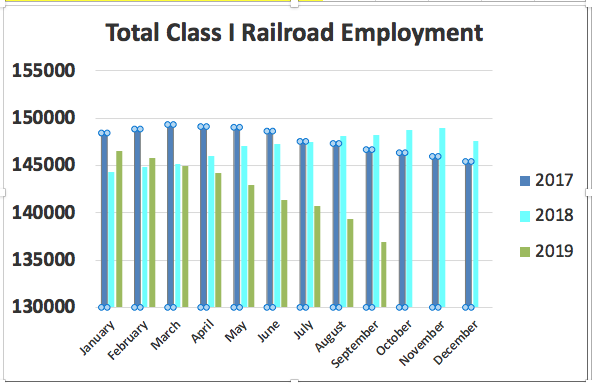WASHINGTON — American railroads shed jobs faster than any other industry in October.
The data point, contained in the Bureau of Labor Statistics jobs report for the month, measures the year-over-year decline in monthly payroll. Railroads were down nearly 8%, leading a group of the fastest-contracting industries, according to Avery Vise, an analyst at FTR Transportation Intelligence.
The employment decline comes primarily from two factors: Class I systems furloughed crews as the year’s traffic decline accelerated, along with broad operational changes related to the implementation of Precision Scheduled Railroading at Norfolk Southern and Union Pacific.
“Rail transportation has been on this list for some time because of structural changes that are ongoing related to Precision Scheduled Railroading and the industry changing how it moves traffic,” says Todd Tranausky, a rail and intermodal analyst with FTR. “What has changed over the last several months is that the rail industry has steadily moved up that list.”
It’s startling, Tranausky says, that railroads could top the list in a month when General Motors workers were on strike.
“That speaks to how quickly the railroads are reacting to the volume downturn,” Tranausky says.
Industry-wide improvements in average train speed and terminal dwell have stalled, suggesting that railroads are not as concerned about moving lower volumes as quickly as they have been as they size their employment levels to a dwindling traffic base, Tranausky says.
Through the week ending Oct. 26, total U.S. rail traffic was down 4.3% for the year to date, according to the latest data from the Association of American Railroads.
Separately, the Surface Transportation Board last week released the latest U.S. Class I railroad employment data for September. Overall railroad employment declined 7.6% year over year and by nearly 2% compared to August.
NS and UP reported the steepest declines in employment during September.
NS is currently operating with its lowest train and engine crew roster ever, executives said during the railroad’s quarterly earnings call last month. When the year began, NS expected overall employment to be down by 500 positions by year’s end. Instead, executives expect the railroad to have 3,200 fewer employees at the end of the year.
Both NS and UP have been moving traffic on fewer but longer trains, further reducing the need for train and engine crews. They’ve also been storing locomotives and freight cars, which reduces the need for locomotive and car shop mechanical forces.
Compared to September 2018, train and engine crew employment was down 7.9% on BNSF, 8.9% on CSX, 2.5% on Canadian National’s Grand Trunk, 12.6% on NS, 0.7% on Canadian Pacific’s Soo Line, and 9.7% on UP, according to STB data.
Train and engine crew employment grew 2.2% on Kansas City Southern, whose cross-border traffic is steadily rising.
















IGIVE.COM raises $9.1 million.
Wiscasset, Waterville, & Farmington Railway Museum $763.96
Washington, DC Chapter, NRHS $910.00
Autism Speaks over $5000.
House of Ruth Maryland over $500.
Maryland Food Bank over $400.
A very successful charity search engine.
The railroads increased investor equity which means their managers get a fat bonus and nothing else matters.
Don’t try to fill those empty cars. Instead store them. After all if you have no customers your operating ratio will be 0. Why have customers after all?
Railroads are moving towards irrelevance
And the truck stop in the town I live in is running over with trucks day in and day out. And this with a brand new truck stop five miles down the road which also stays full. The business is there, railroads don’t want it.
SCHOLARSHIP AMERICA
I hope the Wall Street analysts are happy, now.
Over the past few months, several commentators have predicted a demise of traffic by rail due to PSR. Unfortunately, it now appears that their predictions have come true. While Wall Street may be happy now, they may not be as happy when they learn that other modes of transport are picking up freight customers that once were theirs. The customer is always right, as my late uncle used to say.
The American Trucking Associations reports that For-Hire Truck Tonnage for the 3rd quarter increased 4.5% over the same period last year. Class 1s appear to be on a glide path to a crisis. But Wall Street is happy!
Chris Thompson, the truck stops are full because the Hours of Service law mandates rest breaks and the truckers need places to park while they comply. SHADOW THE CATS OWNER’S has posted about paying to reserve slots for her drivers. In some states, the highway dept. have installed signs ahead of rest areas displaying the number of parking spots available and I have noted trucks parked on the ramps to the rest areas
Trucking isn’t doing so well either. That tonnage increase is was due to getting product in before more tariffs take effect. There was no peak shipping season this year…